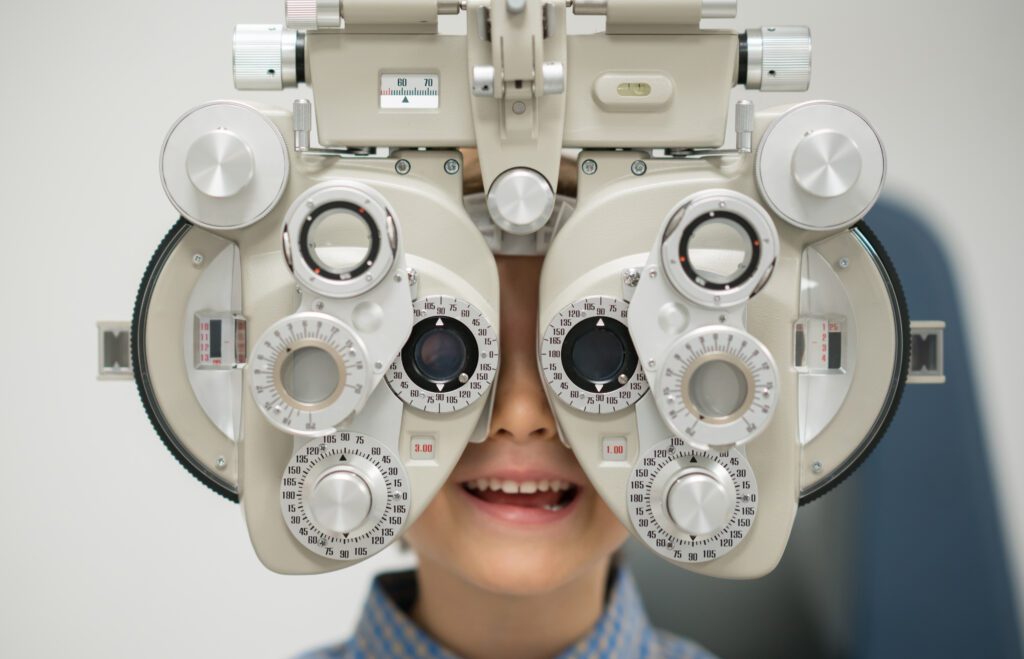Eyesight Is an Important Part of Your Child’s Back-to-School Kit
As children gear up for back-to-school, it’s important to make sure we send them with one of the most important supplies: healthy eyes. Children’s eyes change quickly, so it’s important to watch for small problems to catch them before they become bigger problems. Take our quiz on children’s eye health and set your child up to have a school year that looks bright.
1. True or false? Paying attention to your child’s eye health starts at birth and continues with vision checkups (at a minimum) at 6 months, 3 years, and before first grade.
2. Which of the following are issues to watch concerning a toddler’s vision?
A. Misalignment, or one eye that looks straight ahead while the other eye turns inward, outward, upward, or downward
B. Damage from measles in unvaccinated children
C. Eye damage from chemical burns from cleaning products
D. All of the above
3. Fill in the blank: Farsightedness is when _; and nearsightedness is when ____.
A. A person sees distant objects clearly, but near vision is blurry; close-up objects look clear but distant objects are blurry.
B. A person sees close-up objects clearly, but distant objects are blurry; distant objects look clear, but near vision is blurry.
4. Because eye problems can develop in childhood, which of the following are symptoms of eye problems in childhood?
A. Poor vision, blurry or double vision, difficulty paying attention, and/or focusing problems
B. Jerky eye movements
C. Crossed eyes
D. Cataracts
E. All of the above
5. Not all eye problems that can develop in adolescence are obvious. Which of the following are not-so-obvious signs of childhood vision problems?
A. Sudden loss of interest in activities that require eye use, which may be most apparent as poor school performance and/or not wanting to go to school
B. Losing their place when reading and/or difficulty when reading and writing
C. Turning the head to look at something in front of them
D. Headaches or eye pain
E. All of the above
6. True or false? Vision problems in children can cause learning disabilities.
7. True or false? “Near work” activities—or those that require the eye to focus on something close by, including screen time—may be connected to both nearsightedness and digital eye strain.
8. Which of the following are ways that parents and guardians can help children limit digital eye strain?
A. Limiting screen time, especially at night and before bed
B. Teach children to follow the 20-20-20 rule: Look up from the screen every 20 minutes and focus at least 20 feet away for 20 seconds.
C. Mix “near work” activities like screen time and video game play with “far work” activities such as playing sports or playing outdoors.
D. All of the above
7. True or false? Photos can help diagnose children’s eye problems and save their sight. Problems or abnormalities can be seen when a camera flash reveals a white, yellow, or black reflection in one or both eyes rather than the usual red eye reflection.
8. Which of the following is NOT an eye care professional responsible for helping you and your child with eye health?
A. Ophthalmologist
B. Optometrist
C. Ornithologist
D. Optician
compiled by ERIKA ALDRICH / Resources: Information provided by The American Academy of Ophthalmology and WebMD.
ANSWERS:
True. An eye exam is part of a newborn’s exam, and simple eye exams should be a part of regular pediatric well visits.
D. All of the above
A. Farsightedness is when a person can see far-away objects better than those close-up, and nearsightedness is when a person can see close-up objects better than those that are far away.
E. All of the above
E. All of the above
False. Vision problems like poor vision, lazy eye, and jerky eye movements do not cause learning disabilities.
True. “Near work” activities have been connected with eye strain and nearsightedness.
D. All of the above
True
C. An Ornithologist is a person who studies or is an expert on birds.
